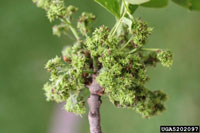Aceria fraxiniflora
Host
Male ash trees
Appearance and Life History

Photo credit: Steven Katovich, USDA Forest Service, Bugwood.org
Ash flower gall mites overwinter as adult females on the bark of host trees. In the spring, the females move to developing male flower buds and deposit their eggs. The larvae emerge and begin feeding on male flowers, creating galls. The larvae, which resemble the adults in appearance, must pass through two stages before maturing into male and female adults. The adult mite has a slender body that is approximately 0.5 mm in length, with two pairs of legs. Several generations are completed throughout the summer within the galls. In the fall, the last generation produces the overwintering adult females.
Damage
The feeding action of the mites causes the flowers to develop abnormally, forming a series of irregularly shaped, fringed galls. The galls range in size from 6-22 mm in diameter. The newly formed galls are green at first, and change to brownish-black near the end of the growing season. The galls remain on the tree during the winter, as conspicuous, unsightly, black masses.
Control
An ash flower gall mite infestation causes no permanent damage to the tree. They can be controlled by pruning out and destroying the newly developed galls in the spring. Planting of female ash or other tree species is also recommended. There are no insecticides registered for control of this mite.